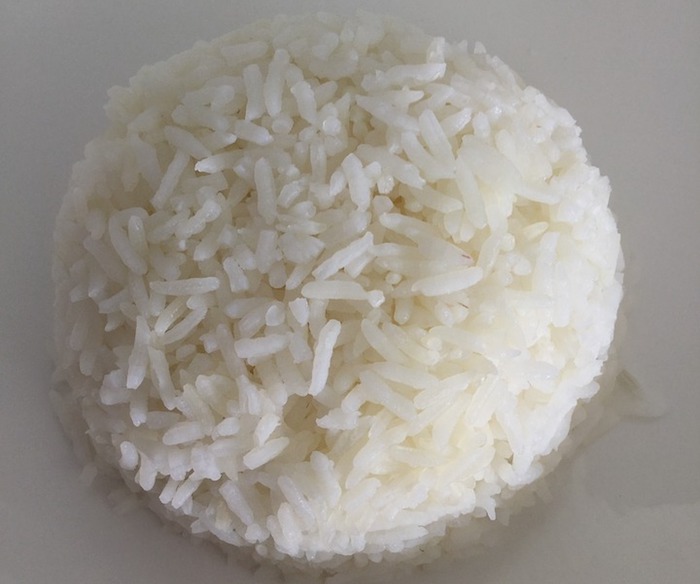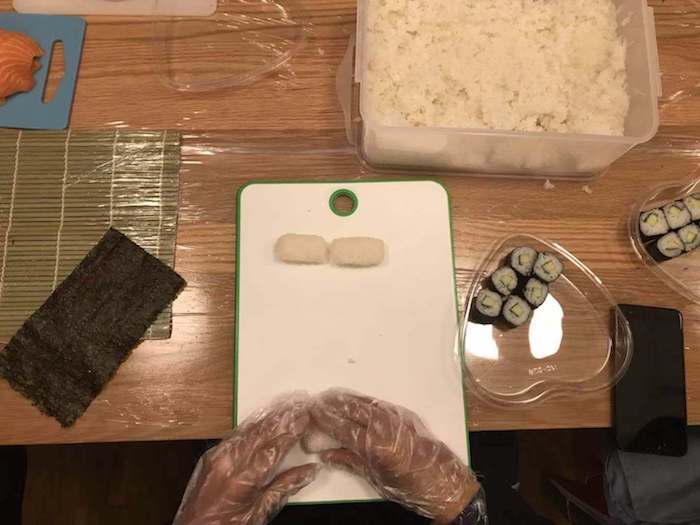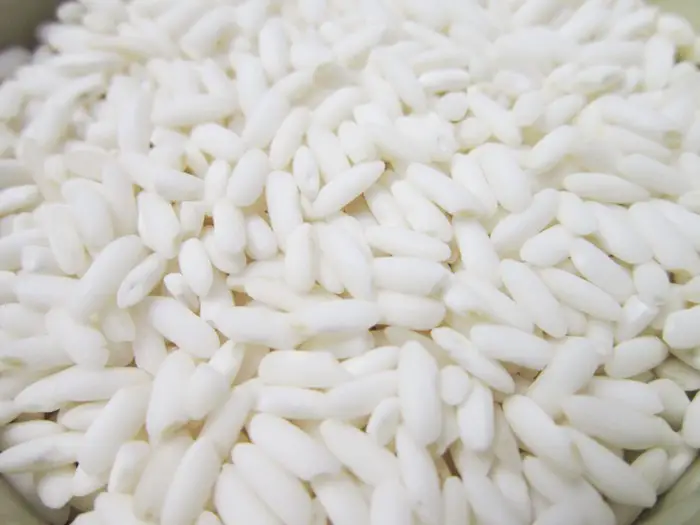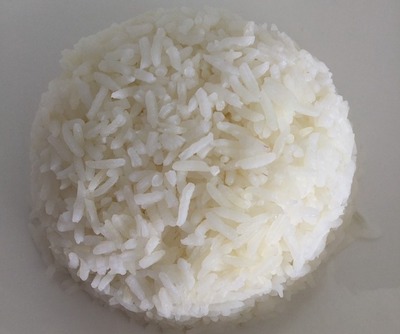We are reader supported. When you purchase through links on our site, we may earn an affiliate commission. Also, as an Amazon affiliate, we earn from qualifying purchases.

Have you ever wondered if any rice is good for making sushi? For example, you really want to eat sushi and you have all the ingredients at home, but you have only jasmine rice. Will that work for sushi?
If you wish for authentic Japanese sushi – avoid jasmine rice. You may think why – rice is rice. But no, jasmine rice is long grain rice and long grain rice doesn’t contain enough starch to hold together a sushi roll. Besides, it has a completely different taste and that would simply not be sushi roll.
I know you might have thought that any rice is good for making sushi, but if you want proper Japanese sushi you need to have short grain rice like this of a special sort of rice called sushi rice. Read on to find out why you shouldn’t use jasmine rice and other interesting details about rice varieties for sushi.
Why you shouldn’t use Jasmine rice
Maybe talking and thinking about rice is not the most exciting part of sushi but rice is what makes sushi – sushi. Did you actually know that you cannot even make sushi without rice? For more inside information click on my recent article.
The rice is what separates great sushi from average or bad sushi, that’s why it’s really important to know which rice to use. Great sushi rice has a special flavor, texture and it sticks perfectly to other ingredients.

While it may surprise you – not all rice is created equally and not any rice will be good for making sushi. Long grain rice like jasmine rice has a dry fluffy texture and grains that don’t stick together. You see the problem now?
On the other hand, short grain rice tends to be more starch and sticks together when making sushi and rolling the rolls. Some other examples of long grain rice include basmati rice, Mexican rice, traditional American long grain white or brown rice as with European long grain white rice.
The jasmine rice can be easily recognized by its length and cylindrically shape, and they are one of the most common rice used, especially in the West. That’s why some people try to experiment when making sushi and use jasmine rice. But, when jasmine rice is cooked the rice will stay fluffy but firm and the grains will not be separated and most importantly – it will not be sticky at all.
And that is the biggest issue if you use jasmine rice for making sushi. Jasmine rice simply won’t give you the right flavor nor texture for making traditional Japanese sushi. Jasmine rice is much drier than sushi rice and your sushi roll won’t stick properly. You won’t enjoy your sushi as you should with jasmine rice.
To reach the goal of eating authentic Japanese sushi you want to use only short-grain Japanese rice for making sushi. Japanese short grain rice is very different from any kind of long grain rice – including jasmine rice as well. It is more liquid, has unique stickiness and simply provides legitimate sushi.
Our recommendation is to buy sushi rice – you can probably get it in any big grocery stores or in Asian stores and even online (Amazon!).
What type of rice can you use for sushi instead of sushi rice
The traditional rice that is used for sushi is short grain Japanese rice that is flavored with vinegar, sugar, and salt. But if you are in a hurry or really want to eat sushi but you don’t have exactly the Japanese sushi rice, what type can you use?
First of all, let’s just repeat you can only make real sushi with authentic Japanese short grain rice. Anything else will taste different, but you can always try with some other type of rice.
Our recommendation would be to make sushi with short grain or medium grain rice. At any case avoid long-grain rice like jasmine or basmati rice. It just won’t stick, and you roll will fall apart.
Short grain rice is sticker and that is essential for your roll to stay together. For example, short-grain brown rice, like other short-grained varieties, has a higher level of amylopectin and that makes it sticky. So short-grain brown rice will be a good substitute for sushi rice.
Moreover, from short grain rice, you can try with arborio rice, that is usually used for making risotto – its creamy and sticky so you roll will stay in one piece. And if you can’t find short-grain rice I have some tips for using medium grain rice sorts that can work well for sushi rolls.
You can make your sushi with medium grain varieties such as Calrose rice. Calrose rice has actually been cultivated in California around the 1950s as a Western version of authentic rice and it would be an excellent alternative to Japanese sushi rice. Calrose is a medium grain Japonica rice that is widely used in many restaurants and is generally available everywhere and many people use it for sushi. Find out more on here.
The other type of medium grain rice you can use is Italian vialone rice that is quite similar to japonica, or Japanese rice.
A similar type of that rice is arborio only less creamy and maybe even better for making a sushi roll. Vialone rice has less starch and works better with holding it all together.
Secret tips for Japanese rice
In Japanese cuisine, there are two basic rice’s used for most of the rice dishes. Of course, both of them are short-grain rice cultivated from Japonica rice.
The first type of rice is called uruchimai and is commonly known as Japanese short grain rice – it’s the rice that is used in most Japanese dishes. This type of rice is used for making sushi, sake and rice vinegar.

The second type of rice is called mochigome and is known as Japanese sweet rice – it is used for making Japanese sweets such as rice cakes. This type of rice is much stickier and has more gluten compared to uruchimai rice.
Although both of them are sticky they are strictly used for different things. Any type of Japanese rice is sticky because of its high proportion of starch and moisture. The logic is simple: when the level of amylose is low, and amylopectin is high (as you already know) you get sticky rice. This unique stickiness of Japanese rice is what makes good sushi and defines the character of Japanese cuisine.
Now that you know the differences between Japanese rice, here are some essential tips for it:
• When you buy Japanese rice, you need to look at a few basic things: its freshness, sweetness, texture, and place of production. It would be ideal if you find ‘shinmain’ rice – this means new rice or the rice that was harvested, processed and packaged in the same year.
• To preserve the moisture and freshness buy smaller packages of the rice so you can use it within a month. Moreover, store your rice away from sun, heat or humidity.
• To prepare the best Japanese rice there is you need to wash it before cooking. Washing the rice will help remove the bran around the rice. Wash the rice two to three times, changing the water each time!
• How to cook rice? With water or with other liquids? With lots of water of course! The advised ratio is one cup of white rice to one cup of water. The rice-to-water ratio might vary slightly from variety to variety if one is to be very particular.
Related Questions
1. Is Japanese rice same as sticky rice?
Well, the answer to this question is yes and no. In Western countries, people often refer to Japanese rice as sticky rice, but sticky rice in itself doesn’t mean anything. Sticky rice is just describing the texture of the rice not the whole sort.
In most the Asian cultures when referring to sticky rice it is typically talking about glutinous or mochigome rice. But, Japanese rice is stickier than all other types of rice but is not the same as sticky rice.
2. How to properly cook sushi rice?
Now that you’ve learned some basic stuff about Japanese rice and which rice can substitute it in sushi, it’s time to learn how to cook the rice properly. You can cook your rice in a pot on a stove or rice cooker.
Hop on to our article to find more information’s: How To Make Sushi Rice In A Rice Cooker ? (also in a pot)
3. Can I use brown rice for sushi?
Despite the fact that brown rice has long been a healthy alternative to white rice and some people use it for making sushi – it is never tasty in sushi rolls.
Brown rice contains a large amount of fiber and that’s why its flavor is earthy, and, in the end, it overrules other ingredients like tuna or salmon. Moreover, when considering the texture, brown rice has much less amylopectin starch – meaning it remains firm even after cooking. That is not something you want in your sushi roll.
So, the bottom line is: yes, you can use brown rice for sushi, but its taste will have almost nothing in common with traditional sushi.

